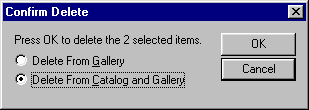Catalogs—especially large ones—that are heavily used and frequently updated can become out-of-date. In addition to routinely backing up all catalogs and source files (and keeping the backups in a safe place), it is a good idea to perform other housecleaning tasks regularly as well. Portfolio provides the catalog manager or administrator with tools that can help with routine catalog maintenance.
Removing Items from a Catalog
The “Delete Items...” command lets you clear a catalog of unwanted or out-of-date items or references.
To remove specific items from a catalog:
In the catalog Gallery window, select the items that you want to delete.
Select “Delete Items...” from the Catalog menu.
The “Delete Items” dialog box is displayed.

Select “Delete from Catalog” (Mac OS) or “Delete from Catalog and Gallery” (Windows), then click “OK.”
Note: Select “Delete from Gallery” if you want to remove the item from the Gallery window only; the item remains in the catalog when you click “OK.”
— or —
In the Gallery window select the items that you delete and press Option+Delete (Mac OS) or Ctrl+Backspace (Windows).
You can easily determine if any file references in a Portfolio catalog are no longer valid using the “Missing Files...” command [Choose Catalog > Missing Items, or press Command+Option+M (Mac OS) or Ctrl+Shift+M (Windows)]. Portfolio only checks for missing files on mounted volumes. See Identifying Missing Files for more information.
Should you ever have trouble opening a Portfolio catalog and suspect that it may have been damaged, you may be able to recover it using the Recover command. Another time to run the Recovery command is when you experience crashes when sorting or searching on a particular field.
To Recover a catalog:
Close the catalog that you want to recover.
You cannot run the Recovery command on an open catalog.
Choose “Recover...” from the File menu, or press Command+Option+V (Mac OS) or Ctrl+Shift+V (Windows).
A directory dialog box is displayed.
Locate the catalog you want to recover, then click “Open.”
A second directory dialog box is displayed.
Type a new name for the recovered catalog, select where you want to save it, then click “Save.”
A progress window is displayed as Portfolio checks the catalog and attempts to repair the damage.
When the completed status report is displayed, click “OK.”
Open the recovered catalog to verify that all the items are intact.